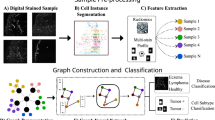Abstract
This study leverages graph neural networks to integrate MELC data with Radiomic-extracted features for melanoma classification, focusing on cellwise analysis. It assesses the effectiveness of gene expression profiles and Radiomic features, revealing that Radiomic features, particularly when combined with UMAP for dimensionality reduction, significantly enhance classification performance. Notably, using Radiomics contributes to increased diagnostic accuracy and computational efficiency, as it allows for the extraction of critical data from fewer stains, thereby reducing operational costs. This methodology marks an advancement in computational dermatology for melanoma cell classification, setting the stage for future research and potential developments.
Access this chapter
Tax calculation will be finalised at checkout
Purchases are for personal use only
Preview
Unable to display preview. Download preview PDF.
Similar content being viewed by others
References
Schubert W. Topological proteomics, toponomics, MELK-technology. Proteomics of Microorganisms: Fundamental Aspects and Application. Berlin, Heidelberg: Springer Berlin Heidelberg, 2003:189–209.
Gao L, Lin F, Han D, Jiang J, Yang C, Zhuang Z et al. Quantitative fluorescence resonance energy transfer analysis on the direct interaction of activation-2b with histone H3/Switch-3B protein in arabidopsis mesophyll protoplasts. J Fluoresc. 2021:981–8.
Ruetze M, Gallinat S, Wenck H, Deppert W, Knott A. In situ localization of epidermal stem cells using a novel multi epitope ligand cartography approach. Integr Biol. 2010;2(5-6):241– 9.
Bonnekoh B, Böckelmann R, Pommer A, Malykh Y, Philipsen L, Gollnick H. The CD11a binding site of Efalizumab in psoriatic skin tissue as analyzed by multi-epitope ligand cartography robot technology: introduction of a novel biological drug-binding biochip assay. Skin Pharmacol Physiol. 2006;20(2):96–111.
Rivera Monroy LC, Rist L, Eberhardt M, Ostalecki C, Baur A, Vera J et al. Employing graph representations for cell-level characterization of melanoma MELC samples. 2023 IEEE 20th International Symposium on Biomedical Imaging (ISBI). 2023:1–5.
Lazic D, Kromp F, Kirr M, Mivalt F, Rifatbegovic F, Halbritter F et al. Single-cell landscape of bone marrow metastases in human neuroblastoma unraveled by deep multiplex imaging. bioRxiv. 2020:2020–9.
Liang W,Wang B, Tao J, Peng M, Tu X, Qiu X et al. A machine learning–based multidimensional model integrating clinical, radiomics, and cell-free DNA methylation biomarkers for the classification of pulmonary nodules. J Clin Oncol. 2023;41(16_suppl):3070–0.
Pattarone G, Acion L, Simian M, Mertelsmann R, Follo M, Iarussi E. Learning deep features for dead and living breast cancer cell classification without staining. Sci Rep. 2021;11(1):10304.
Gómez OV, Herraiz JL, Udías JM, Haug A, Papp L, Cioni D et al. Analysis of crosscombinations of feature selection and machine-learning classification methods based on [18F] F-FDG PET/CT radiomic features for metabolic response prediction of metastatic breast cancer lesions. Cancers (Basel). 2022;14(12):2922.
Mercaldo F, Brunese MC, Merolla F, Rocca A, Zappia M, Santone A. Prostate gleason score detection by calibrated machine learning classification through radiomic features. Appl Sci. 2022;12(23):11900.
Chopra A, Sharma R, Rao UN. Pathology of melanoma. Surg Clin. 2020;100(1):43–59.
Albrecht M, Lucarelli P, Kulms D, Sauter T. Computational models of melanoma. Theor Biol Med Model. 2020;17(1):1–16.
Pachitariu M, Stringer C. Cellpose 2.0: how to train your own model. Nat Methods. 2022;19(12):1634–41.
Wolf FA, Angerer P, Theis FJ. SCANPY: large-scale single-cell gene expression data analysis. Genome Biol. 2018;19:1–5.
Palla G, Spitzer H, Klein M, Fischer D, Schaar AC, Kuemmerle LB et al. Squidpy: a scalable framework for spatial omics analysis. Nat Methods. 2022;19(2):171–8.
Griethuysen JJ van, Fedorov A, Parmar C, Hosny A, Aucoin N, Narayan V et al. Computational radiomics system to decode the radiographic phenotype. Cancer Res. 2017;77(21):e104–e107.
Ardizzoni S, Saccani I, Consolini L, Locatelli M. Local optimization of MAPF solutions on directed graphs. 2023.
Wang HY, Zhao Jp, Zheng CH. SUSCC: secondary construction of feature space based on UMAP for rapid and accurate clustering large-scale single cell RNA-seq data. Interdiscip Sci. 2021;13:83–90.
Do VH, Canzar S. A generalization of t-SNE and UMAP to single-cell multimodal omics. Genome Biol. 2021;22(1):1–9.
Pati P, Jaume G, Fernandes LA, Foncubierta-Rodríguez A, Feroce F, Anniciello AM et al. Hact-net: A hierarchical cell-to-tissue graph neural network for histopathological image classification. Uncertainty for Safe Utilization of Machine Learning in Medical Imaging, and Graphs in Biomedical Image Analysis. Springer. 2020:208–19.
Feng W, Zhang J, Dong Y, Han Y, Luan H, Xu Q et al. Graph random neural networks for semi-supervised learning on graphs. Adv Neural Inf Process Syst. 2020;33:22092–103.
Author information
Authors and Affiliations
Corresponding author
Editor information
Editors and Affiliations
Rights and permissions
Copyright information
© 2024 Der/die Autor(en), exklusiv lizenziert an Springer Fachmedien Wiesbaden GmbH, ein Teil von Springer Nature
About this paper
Cite this paper
Monroy, L.C.R. et al. (2024). Comparative Analysis of Radiomic Features and Gene Expression Profiles in Histopathology Data using Graph Neural Networks. In: Maier, A., Deserno, T.M., Handels, H., Maier-Hein, K., Palm, C., Tolxdorff, T. (eds) Bildverarbeitung für die Medizin 2024. BVM 2024. Informatik aktuell. Springer Vieweg, Wiesbaden. https://doi.org/10.1007/978-3-658-44037-4_49
Download citation
DOI: https://doi.org/10.1007/978-3-658-44037-4_49
Published:
Publisher Name: Springer Vieweg, Wiesbaden
Print ISBN: 978-3-658-44036-7
Online ISBN: 978-3-658-44037-4
eBook Packages: Computer Science and Engineering (German Language)




